

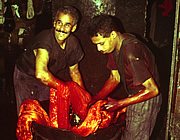
On our first visit to Morocco we came to this fascinating city. The people are extremely friendly - though scary drivers! The Djemaa el Fna square is full of atmosphere and gives a wonderful glimpse into the lives of the country people. The artisans' areas in the souks the most fascinating of all.
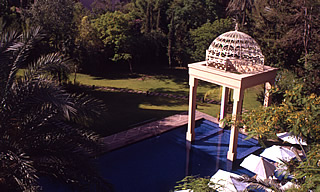
We flew in to Agadir arriving mid-afternoon and were met by Hayat who escorted us on the five hour drive to Marrakech. All of the rivers we passed looked very dry, and the one reservoir very low.
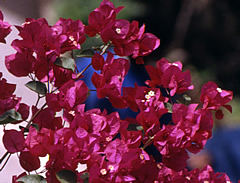
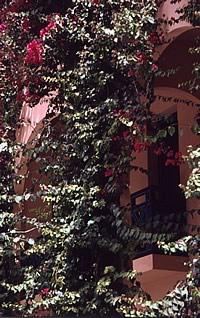
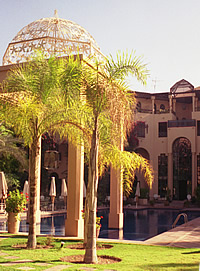
We drove through the foothills of the High Atlas: all scrubby bushes and thorny trees. Life looks very primitive here - donkeys used for transport, herds of black goats - but everywhere in the small towns and villages looks very clean. Halfway through the journey we stopped at a café where Hayat insisted we share her Tajik - a kind of meat stew with potatoes and olives served with Moroccan bread - very good. Not so keen on the mint tea. Everyone is extremely friendly. We were too tired to notice much about Marrakech or the hotel when we arrived or to eat anything - just showered and off to bed.
We had chosen to stay at the Hotel Tichka because it has strong Moroccan influence in its design - modern hotels so often have no flavour of the country you are in.
We also wanted, at least partly, and the Tichka is peaceful and has shady, pleasant gardens and a nice pool. Though we weren't impressed with their International Restaurant, the Moroccan restaurant was excellent.

We both, however, suffered from bad stomachs for a couple of days at one point in the holiday and had to resort to a local pharmacy for medication (an experience in itself - the taxi driver causing a minor traffic jam at a roundabout where another car bumped him deliberately - he didn't seem too concerned!).
We're not sure how we got it but it could be bottled water which may instead have been filled at the tap - lesson: always insist that you break the seal on your bottles of water!

One lunchtime we met Hayat for an excellent Moroccan meal in a local restaurant. We had soup, Pastilla and lamb and prune tajine among a lot of other small dishes. She was so kind and friendly and invited us back to visit her family in their home which was wonderful for us. Her large family were all asleep when we arrived, but Hayat assured us we weren't disturbing them. Her home was very cool being built around a tiled courtyard which had a sliding roof. Conversation was, of course, not easy but Hayat translated and everyone seemed happy. It was really nice to be welcomed into her family.
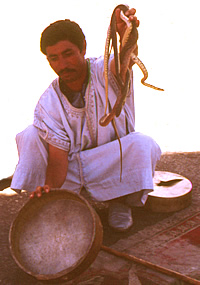
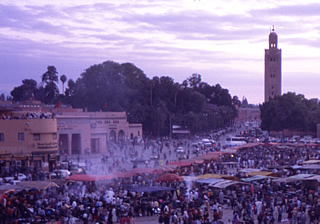
Marrakech is Berber rather than Arab and has probably been in existence for over a thousand years. In the eleventh century its Almarovid founders brought craftsmen and architects from Cordoba to work here and in the 12th century the first city walls were built to encircle the city. Although many times rebuilt these are essentially the walls which can be seen today.
Djemaa el Fna is probably as old as the city itself, in that a public meeting place would have been present here from the time of the city's foundation.
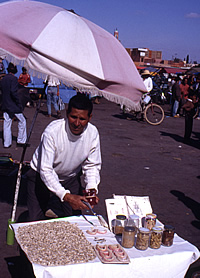
By day this square is a fascinatingly diverse market. We began a visit here with a guide in late afternoon and were immediately enchanted with it all. It's noisy and colourful and a feast for the eyes with water sellers and snake charmers and dentists and herbalists and lots of musicians, stalls piled high with oranges and nuts. By early evening it is even livelier with lots of food vendors now catering to the crowds who are variously eating spicy sausages, soup and chips!
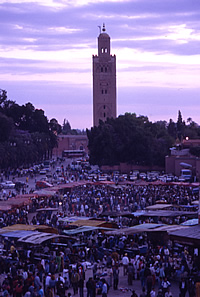
Everything is obviously geared for the tourist but here the tourists are mostly Berbers from the mountains; we saw no more than half a dozen European faces in all the time we wandered the Djemaa el Fna and the souks.
The Almohad dynasty replaced the Almoravids and it was during the reign of Sultan Yacoub el Mansour that the Koutoubia Minaret, towering over Djemaa el Fna, was completed towards the end of the twelfth century. It is the oldest of the three great Almohad towers, the others being in Rabat and Seville The minaret can be seen from miles away on a clear day - it is nearly seventy metres high. Its proportions of 1:5 ratio of width to height established the classic Moroccan design.
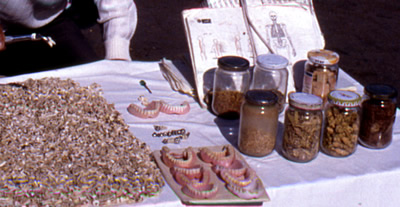
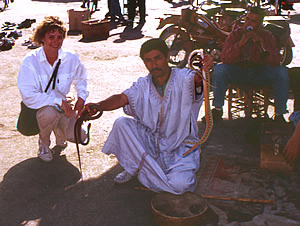
Later, we had drinks on the balcony of the Cafe de France from which there is a grand view of the Djemaa el Fna, Koutoubia Minaret and entrance to the souks.
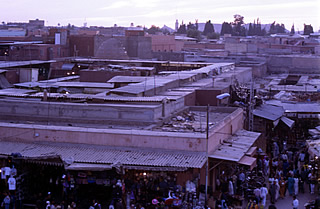
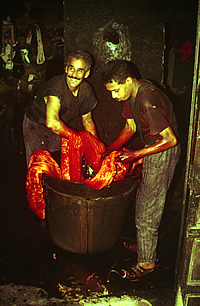
Our guide, Aziz, took us into the souks - a maze of thousands of shops and artisans work places.
The shops are divided into areas, so there is an area of shops which sell wooden goods made in the mountains and brought into Marrakech for sale, others for leather goods, ceramics, clothing such as kaftans and djellabas, spices and jewellery - especially silver and huge Berber necklaces of coral and amber.
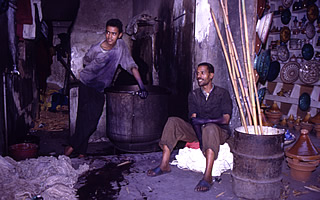
All the shopkeepers pester to get you into their shop 'just to look' and they practice very hard-sell techniques. Most goods start at around 500Dh, for example large ceramic plates, necklaces; if you then offer say 100Dh they react with a common "100 dollars?" and despairing looks as though you are mad. I like bargaining, and am quite happy to engage in it wherever it seems appropriate but here it was very aggressive and not at all good-natured.
The absolute worst was a spice seller who dragged us into his shop, gave us some long story about his spices and then tried to sell us stuff we didn't want. There was no room for politeness with this man and in the end we simply had to turn our backs and walk out, ignoring his yells (and curses!) behind us.
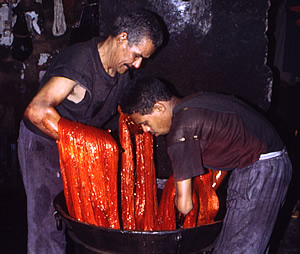
By employing tactics such as walking out and sticking to the price you are happy with you can get what you want but it takes time and is not so enjoyable. And even then you can be duped - we bought what we thought was a walnut pot and picture frame (200Dh down from 500Dh) - back home our poor picture framer said she had a devil of a job piercing the frame - it certainly isn't made of wood!
But we also got some beautiful bright blue and yellow ceramic bowls with silver rims, which were excellent value at 90Dh each.
Aziz said that bargaining for well-priced objects such as the bowls would gain very little, that the larger prices give more leeway for bargaining. Apparently Brits are known to be hard bargainers and always pleading poverty, Americans just pay up and the Spanish are hard bargainers but usually buy a lot.
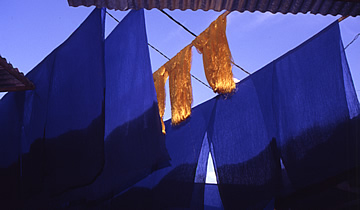
We spent about three hours in the souks, penetrating deep into the depths of the artisans area - Aziz said most tourists don't make it that far as it is impossible to take a large group. The artisans area is by far the most interesting part of the souks: ironworkers, with clay ovens like pizza ovens, one man working two huge bellows while two others hammer the red hot metal; leather workers pounding and softening skins and stamping out shapes ready to sew into pouffes; dyers upto their elbows in boiling vegetable dyes: indigo, saffron, henna, rose, quite happy to have their photographs taken for a 5 Dirham tip. These people were so much nicer than the aggressive shopkeepers.
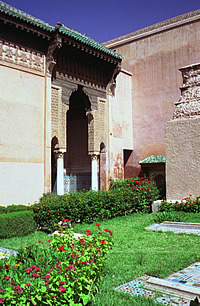
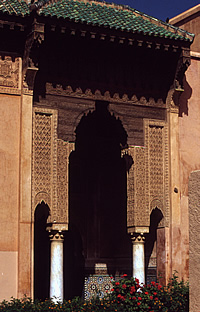
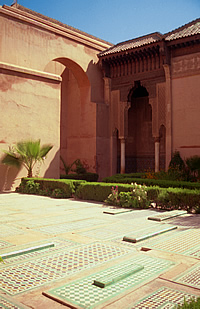
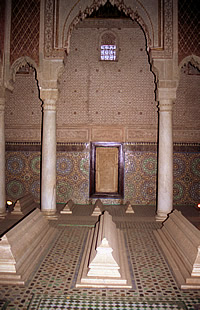
Our taxi ride to the tombs nearly didn't get going - a French driver backed into the taxi as we were leaving the hotel, admittedly our driver wasn't looking where he was going, but he was on the main road. Negotiations looked like they might be protracted, several more cab drivers joining the deliberations. We swapped to another cab and made it to the tombs without further incident.
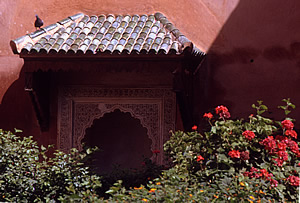
The Saadians were Arabs who ruled Morocco for ajust over a hundred years from 1554. Their greatest sultan was Ahmed el Mansour who built El Badi as his royal palace and these tombs are its mausoleums.
The oldest tomb dates from 1557 and El Mansour was buried here in a beautifully ornate mausoleum when he died in 1603 and is surrounded by tombs of sons and heirs.
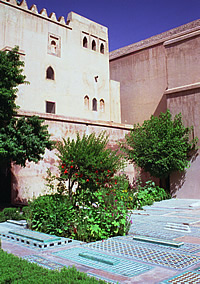
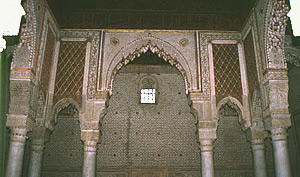
The Tombs are very beautiful and, when all the tourists leave, very peaceful. Inside the mausoleums are the tombs of sixty six members of the Saadian Royal Family.
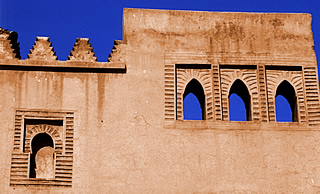
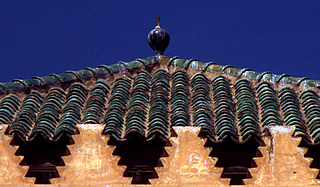
Outside in the courtyard and gardens are many more tiled tombs of family members and their household.
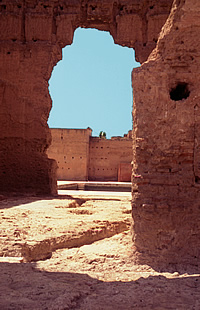
We took the Rough Guide route to El Badi through fascinating streets., very busy with men loading and unloading sacks of sugar and flour, fruit and vegetable sellers, donkeys hauling loaded carts. Usually the streets are very clean and don't smell at all but where a few donkeys or horses are gathered the smell can be unpleasantly strong.
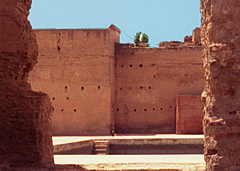
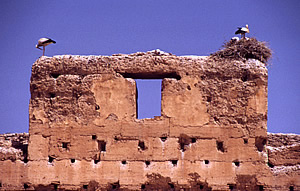
At the palace we rejected the advances of guides and used the Rough Guide in our stroll in the shadow of the walls where many storks have their nests.
El Badi (The Incomparable) lies mostly in ruins, but is vast and must have been fabulous in its day. The money to build it came from an enormous ransom paid by the Portuguese after the Battle of the Three Kings at Ksar el Kebir in 1578. Ahmed - dubbed El Mansour: the Victorious - reigned for 25 years of relative peace. This was a prosperous time when trade with Europe in sugar and slaves brought good income. Ahmed also captured Timbuktu thus securing the gold route across the Sahara and earning him the additional title El Dhahibi - The Golden.
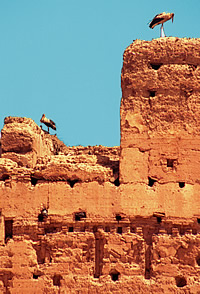
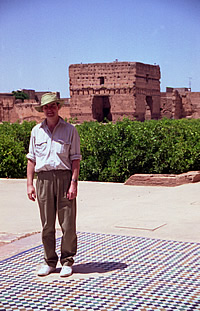
The visible remains of the palace are thought to be the ceremonial areas, used for receiving and entertaining ambassadors and important visitors. Smaller private palaces are thought to have existed to the west and south for everyday living.
The ruins encompass a central court which once had magnificent gardens and pools, not usually filled these days, surrounded by summer pavilions, as well as the more down-to-earth buildings such as stables and dungeons.
Very, very hot so beat a retreat to the hotel pool!
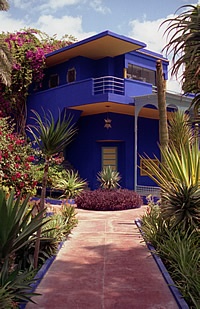
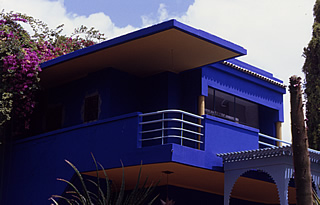
Created in the 1920s by a minor French artist, Louis Majorelle, this garden is now owned by Yves St Laurent.
The gardens are lovely, cool and filled with the scent of honeysuckle.
There is a mixture of Japanese and Art Deco influences in the little bridges, lily ponds and central blue building. Lots of succulents and masses of bougainvillea.
Being a big fan of both Art Deco and gardens I loved this place.
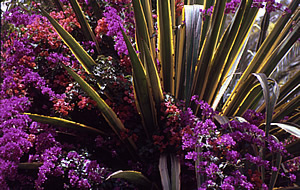

One evening we also paid a visit to the Hotel Mamounia - Winston Churchill was a frequent visitor to Marrakech and it is said this was his favourite hotel anywhere in the world. It's a fabulous hotel with huge rooms filled with marble, many pools of water, deep-cushioned chairs. The gardens are lovely, cool under the groves of trees and with views of the Koutoubia: a very pleasant place to relax in the heat of the day.